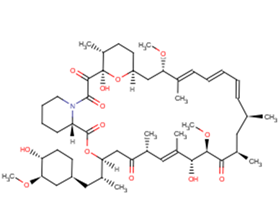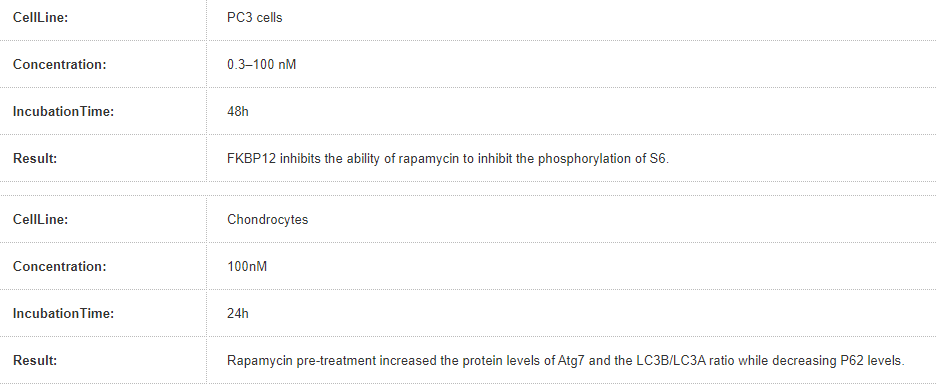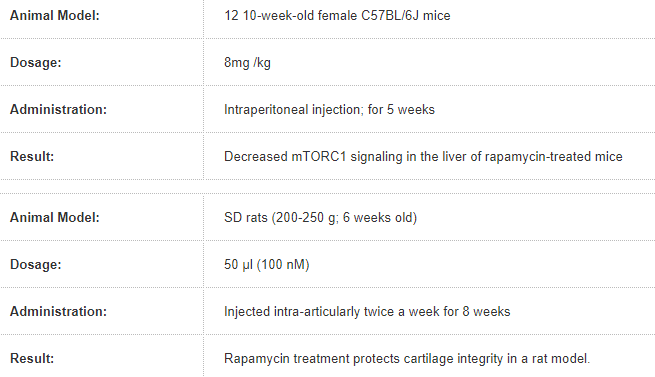



All products from TargetMol are for Research Use Only. Not for Human or Veterinary or Therapeutic Use.
Biological Description
Description: Rapamycin, a macrolide compound obtained from Streptomyces hygroscopicus, is a potent and specific mTOR inhibitor (IC50: 0.1 nM in HEK293 cells).
Targets&IC50: mTOR:0.1 nM (HEK293 cells)
In vitro: HEK293 cells were treated with rapamycin (0.05-50 nM), iRap (0.5-500 nM), or AP21967 (0.5-500 nM) under conditions that stimulate mTOR kinase activity. All three compounds were found to inhibit endogenous mTOR, with IC50 values of ~0.1 nM for rapamycin, ~5 nM for iRap and ~10 nM for AP21967. Rapamycin inhibited the secretion of VEGF in CT-26 adenocarcinoma cell. Amounts of VEGF mRNA were slightly lower (4-fold) in rapamycin-treated (0.1 μg/ml) B16 tumor cells than in controls. CT-26 and B16 tumor cell proliferation decreased moderately in the presence of rapamycin, but only at the highest concentration tested (1 μg/ml). HUVECs were very sensitive to rapamycin, with a significant effect at 0.01 μg/ml. VEGF-induced HUVEC tubular formation was completely abrogated by concentrations of rapamycin as low as 0.01 μg/ml. Rapamycin-induced autophagy but not apoptosis in rapamycin-sensitive malignant glioma U87-MG and T98G cells by inhibiting the function of mTOR. In contrast, in rapamycin-resistant U373-MG cells, the inhibitory effect of rapamycin was minor, although the phosphorylation of p70S6 kinase, a molecule downstream of mTOR, was remarkably inhibited.

In vivo: Rapamycin in vivo did not alter the phosphorylation or activity of Akt itself or of its mTOR-independent target GSK-3β, but instead specifically blocked targets known to be downstream of mTOR12–17. Rapamycin in vivo almost completely prevented the hypertrophic increases in plantaris muscle weight and fiber size at 7 and 14 days. Cardiomyocytes isolated from rapamycin-treated (2 mg/kg body weight, i.p.) LS/+ mice had significantly decreased cell size as compared with that of vehicle-treated LS/+ cells. Mice receiving relatively low doses of RAPA (1.5 mg/kg/d) showed a slightly delayed increase in tumor size during the first 20 days. The lowest dose of RAPA (0.15 mg/kg/d) delayed tumor growth slightly, but the mice died by day 23. A high dose of RAPA (15 mg/kg/d) caused a more pronounced delay in tumor development during the first 3 weeks, but after this, the tumors began to grow again rapidly and the mice died shortly thereafter.

Kinase Assay: HEK293 cells were plated at 2-2.5 × 10^5 cells per well of a 12-well plate and serum-starved for 24 h in DMEM only. Cells were mock-treated or treated with rapamycin (0.05-50 nM), iRap (0.5-500 nM), or AP21967 (0.5-500 nM) for 15 minutes at 37 °C. Serum was added to a final concentration of 20% for 30 minutes at 37 °C. Cells were lysed as described and cell lysates were separated by SDS-PAGE. Resolved proteins were transferred to a PVDF membrane and immunoblotted with a phosphospecific primary antibody against Thr389 of p70 S6 kinase. Data were analyzed using ImageQuant and KaleidaGraph.
Cell Research: To determine the effects of rapamycin and rapamycin plus LY294002 or UCN-01 on tumor cells, we determined cell viability after the treatments. We used a trypan blue dye exclusion assay as described previously. Tumor cells in exponential growth were harvested and seeded at 5 × 10^3 cells per well (0.1 mL) in 96-well flat-bottomed plates and incubated overnight at 37°C. The cells were then incubated for 72 hours with or without rapamycin or with rapamycin plus LY294002 or UCN-01. After the cells were collected by trypsinization, they were stained with trypan blue, and the viable cells in each well were counted. The viability of the untreated cells (the control) was considered 100%. Survival fractions were calculated from the mean cell viability of the treated cells.
Animal Research: Animals were randomized to treatment or vehicle groups so that the mean starting body weights of each group were equal. Drug treatment began on the day of surgery or on the first day of reloading after the 14-day suspension. Rapamycin was delivered once daily by intraperitoneal injection at a dose of 1.5 mg/kg, dissolved in 2% carboxymethylcellulose. CsA was delivered once daily by subcutaneous injection at a dose of 15 mg/kg, dissolved in 10% methanol and olive oil. FK506 was delivered once daily via subcutaneous injection at a dose of 3 mg kg?1, dissolved in 10% ethanol, 10% cremophor and saline.
Chemical Properties
Molecular Weight: 914.18
Formula: C51H79NO13
CAS No.: 53123-88-9
Storage & Solubility Information
Storage
Powder: -20°C for 3 years
In solvent: -80°C for 2 years
Solubility Information
Ethanol: 18.3 mg/mL (20 mM)
H2O: Insoluble
DMSO: 45.7 mg/mL (50 mM)
( < 1 mg/ml refers to the product slightly soluble or insoluble )
Catalog #: T1537
Please email us at cs@medikonia.com for any enquiry. To place an order, please include the catalog number(s) of the product(s) in the email.
References and Literature